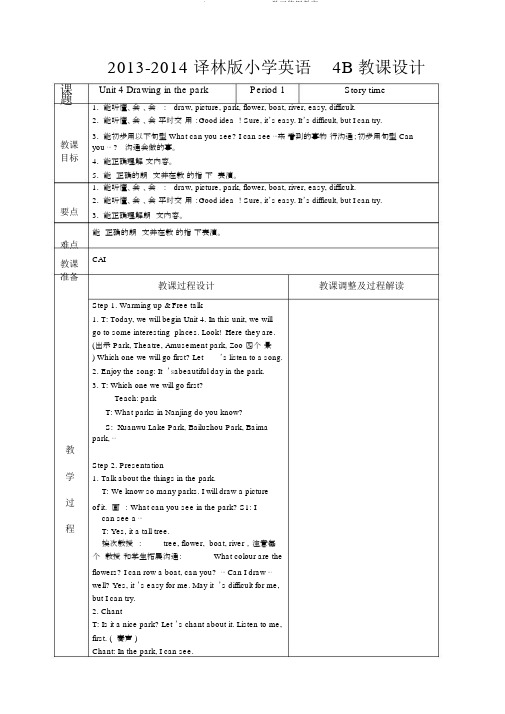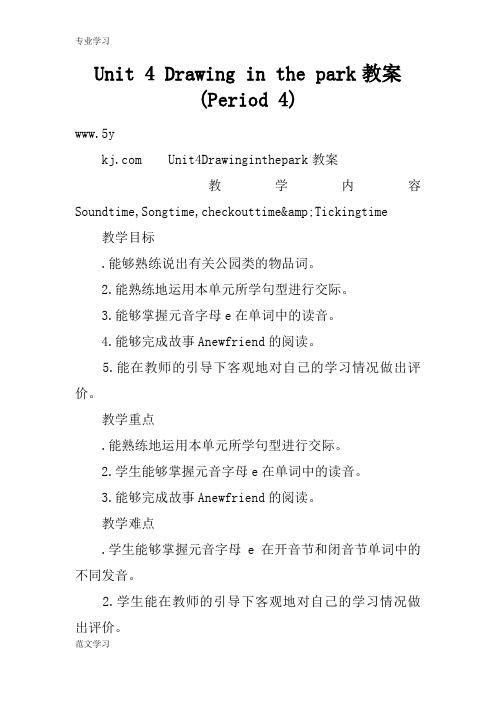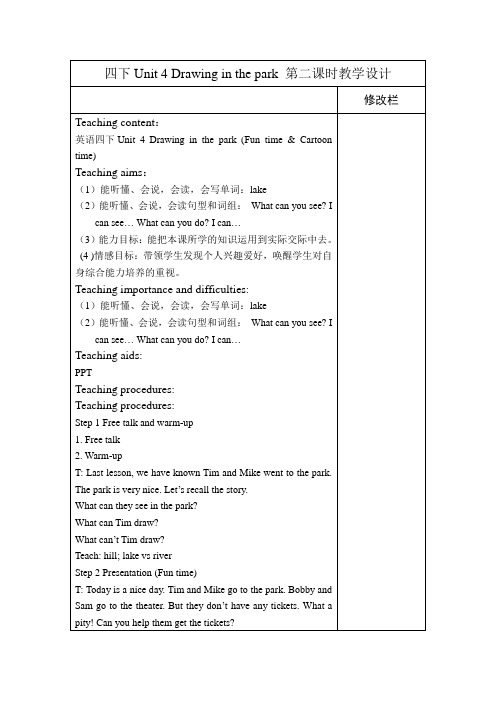Unit 4 Drawing in the Park教案4
- 格式:doc
- 大小:30.01 KB
- 文档页数:2

Unit 4 Drawing in the park【教材分析】:本单元的主要教学内容是用I can see...的句型描述公园里的事物。
教学时可以利用电脑课件引导学生在观察中理解所学语言。
要求学生从听,说,读,写四个方面掌握句型“What can you see...?”以及回答和四会单词,要求学生能准确识记单词,并且学会运用。
也可以结合四年级上册Unit 4的句型I can ... Can you ...?来归纳总结情态动词can的用法,以便学生全面掌握和综合运用。
【教学目标】1. 能听懂、会说、会读单词:draw, picture, park, flower, boat, river, easy, difficult.2. 能听懂、会读、会说日常交际用语:Good idea!Sure, it’s easy. It’s difficult, but I can try.3. 能初步用以下句型What can you see? I can see …来对看到的事物进行交流;初步用句型Can you …? 询问交流会做的事。
4. 能正确理解课文内容。
5. 能够较准确的朗读课文并在教师的指导下尝试表演。
【教学重难点】1. 能听懂、会说、会读单词:draw, picture, park, flower, boat, river, easy, difficult.2. 能听懂、会读、会说日常交际用语:Good idea!Sure, it’s easy. It’s difficult, but I can try.3. 能正确理解朗读课文内容。
【教具准备】:1.多媒体课件2.录音机、磁带3.图片、实物、头饰【课时划分】Period 1 Story timePeriod 2 V ocabulary & Fun timePeriod 3 Revision & Cartoon timePeriod 4Sound time, Song time, Checkout time &Ticking timeUnit 4 Drawing in the park第一课时【教学内容】Unit 4 Drawing in the park(Story time)【教学目标】1. 能听懂、会说、会读单词:draw, picture, park, flower, boat, river, easy, difficult.2. 能听懂、会读、会说日常交际用语:Good idea!Sure, it’s easy. It’s difficult, but I can try.3. 能初步用以下句型What can you see? I can see …来对看到的事物进行交流;初步用句型Can you …? 询问交流会做的事。

课题教课目标要点难点教课准备教学过程2013-2014 译林版小学英语4B 教课设计Unit 4 Drawing in the park Period 1Story time1.能听懂、会、会: draw, picture, park, flower, boat, river, easy, difficult.2.能听懂、会、会平时交用:Good idea !Sure, it’s easy. It’s difficult, but I can try.3.能初步用以下句型 What can you see? I can see ⋯来看到的事物行沟通;初步用句型 Can you ⋯ ? 沟通会做的事。
4.能正确理解文内容。
5.能正确的朗文并在教的指下表演。
1.能听懂、会、会: draw, picture, park, flower, boat, river, easy, difficult.2.能听懂、会、会平时交用:Good idea !Sure, it’s easy. It’s difficult, but I can try.3.能正确理解朗文内容。
能正确的朗文并在教的指下表演。
CAI教课过程设计教课调整及过程解读Step 1. Warming up & Free talk1. T: Today, we will begin Unit 4. In this unit, we willgo to some interesting places. Look! Here they are.(出示 Park, Theatre, Amusement park, Zoo 四个景) Which one we will go first? Let’s listen to a song.2.Enjoy the song: It ’s abeautiful day in the park.3.T: Which one we will go first?Teach: parkT: What parks in Nanjing do you know?S:Xuanwu Lake Park, Bailuzhou Park, Baimapark, ⋯Step 2. Presentation1.Talk about the things in the park.T:We know so many parks. I will draw a pictureof it. 画: What can you see in the park? S1: Ican see a ⋯T: Yes, it a tall tree.挨次教授:tree, flower, boat, river ,注意每个教授和学生拓展沟通:What colour are theflowers? I can row a boat, can you? ⋯ Can I draw ⋯well? Yes, it ’s easy for me. May it ’s difficult for me,but I can try.2. ChantT:Is it a nice park? Let ’s chant about it. Listen to me,first. ( 奏声 )Chant: In the park, I can see.See some trees, over there.In the park, I can see.See some flowers, under the tree.S:Chant together.3.Change some words and try to make a new chant.4.T: What can you do in the park? I can row a boat.S: I can fly kites/ play football/ride bike/⋯Step.3. Enjoy the story:1. T: Good, Mike and Tim are in the park now. Whatdo they do? Let ’s have a look! ( 出示 1)T:出局部,学生猜。

译林英语四下教案Unit 4 Drawing in the park 第二课时教案标题:Unit 4 Drawing in the park(第二课时)教学目标:1. 让学生能够理解本课时所涉及的单词和短语。
2. 帮助学生掌握“could”表达能力,并在复数形式和否定形式使用该词。
3. 让学生能够使用所学知识,问和回答有关能力的问题。
4. 通过本课的学习,激发学生对于美术创作的兴趣。
教学重点:1. 理解并正确使用本课所涉及的单词和短语。
2. 正确使用“could”表达能力,并在复数形式和否定形式使用该词。
3. 能够使用所学知识,问和回答有关能力的问题。
教学难点:1. 帮助学生正确理解和掌握“could”表示能力的用法。
2. 让学生实际动手练习,提高他们对于美术创作的兴趣和技能。
教学准备:1. 单词卡片。
2. 课本和教学PPT。
3. 美术材料,例如:纸张、画笔、颜料等。
教学过程:Step 1: Warm-up1. Have students review the vocabulary learned in the previous class by playing a game of charades. Divide the class into two teams. One student from each team comes to the front of the class to act out a vocabulary word while their team tries to guess the word.2. Review the grammar structure of “can” and “could”. Explain that “could” is the past tense of “can” and is used to express ability in the past.Step 2: Vocabulary Preview1. Introduce new vocabulary words, including “draw”, “paint”, “watercolor”, “pastel” and “canvas”. Show pictures of the different types of art materials and have students repeat the words.2. Discuss what the new words mean and ask students to use them in a sentence.Step 3: Presentation1. Read the dialogue in the textbook with the students. Allow them to take turns reading a sentence or a paragraph.2. Explain that the characters are discussing their drawing abilities and what they like to draw. Discuss how the use of “could” expresses ability in the past.3. Use real life examples to help students understand the grammar point. For example, “I could swim when I was younger” or “He could speak Spanish fluently but now he has forgotten most of it”.Step 4: Practice1. Have the students work in pairs to practice asking and answering questions using the verb “could”. For example, “Could you play the piano when you were younger?”“Yes, I could.”2. Encourage students to ask follow-up questions to get more information. For example, “What kind of paintings could you make?”3. Ask students to draw a picture using their favorite art materials. Provide guidance on what to draw, such as a park or a portrait. Encourage them to use the newvocabulary words learned in class and offer positive feedback on their drawings.Step 5: Assessment1. Have individual students come to the front of the class to talk about what art materials they used in their drawing and what they drew.2. Assess students’ use of the vocabulary words andthe “could” structure. Offer feedback on areas where they can improve.Step 6: Closure1. Recap the key points of the lesson with the students.2. Encourage students to continue practicing their drawing skills.3. Assign homework, such as writing a short paragraph about their favorite type of artwork or drawing a pictureof their family using their favorite art materials.教学反思:通过本课的教学,学生成功地学习了关于能力的单词和短语,以及如何正确地使用“could”表达过去的能力。

Unit 4 Drawing in the park教案(Period 4)www.5y Unit4Drawinginthepark教案教学内容Soundtime,Songtime,checkouttime&Tickingtime 教学目标.能够熟练说出有关公园类的物品词。
2.能熟练地运用本单元所学句型进行交际。
3.能够掌握元音字母e在单词中的读音。
4.能够完成故事Anewfriend的阅读。
5.能在教师的引导下客观地对自己的学习情况做出评价。
教学重点.能熟练地运用本单元所学句型进行交际。
2.学生能够掌握元音字母e在单词中的读音。
3.能够完成故事Anewfriend的阅读。
教学难点.学生能够掌握元音字母e在开音节和闭音节单词中的不同发音。
2.学生能在教师的引导下客观地对自己的学习情况做出评价。
教学准备补充阅读材料教学过程Step1.warmingup&Freetalk.Enjoythesong:Rowyourboat2.T:stlesson,wewenttothepark,th etheatreandtheAmusementpark.Today,wewillgotoanother interestingplace–Zoo.Let’sgo.Step2.Revision.T:Inthezoo,whatcanyousee?Let’splayagame.Non-stoptalking.要求:10秒内小组轮流说:两个关键词:Animalsinthezoo,theotherthingsinthezoo.S:Icansee…2.T:Let’sgoandhavealook.k:Hi,canIgowithyou?T:cankangowithus?S:Sure.T:ok.Let’sgo.Step3.checkouttimeandsongtime.(和手偶互动)T:Look,thisisapictureofazoo.Howbeautiful!whatcanyou seeinthispicture?k:Icansee…T:canyou…?Howmany…canyousee?k:yes,Ican.…T:Lookat…k:Howbeautiful!...2.结合所给句型,谈论图片。

Unit4 Drawing in the park 第三课时(说课稿)一、教学目标1.能够听懂并理解课文内容;2.能够模仿并掌握课文中出现的句型和单词;3.能够通过本节课的练习提高英语口语和听力水平。
二、教学重点1.了解课文的基本内容,能够简单地用英语讲述;2.掌握课文中出现的一些单词和短语;3.初步激发学生热爱绘画的兴趣。
三、教学难点1.学生的英语口语和听力水平相对较低,需要多次反复练习;2.学生可能缺乏绘画基础,需要通过课堂练习提高。
四、教学准备1.教材《英语》四年级下册;2.课文原文和简化版;3.粉笔、黑板、课件、PPT等。
五、教学内容和步骤本节课的教学内容主要包括听、说、读、写和绘画等几个方面。
具体步骤如下:1. 自我介绍教师通过简单的自我介绍,了解学生的学习情况和英语水平。
2. 课文朗读教师请学生跟读课文,注意语音语调的正确性,并指导学生朗读正确的单词和短语。
3. 课文理解和讲述教师讲解课文中重要的单词和短语,并让学生边听边记录。
然后询问学生对课文的理解和讲述,让学生口语练习和提高听写能力。
4. 视频欣赏教师播放一段有关绘画的短片,介绍绘画的种类和方法,激发学生的兴趣和想象力。
5. 绘画练习教师布置绘画任务,让学生根据自己的想象画出一幅图画,并在图画上用英语写下自己的感受和想法。
6. 练习分享教师让学生分享自己的作品和感受,并进行评比和点评,提高学生的创意和表达能力。
六、教学反思本节课通过课文、视频和绘画等多种途径,从听、说、读、写几个方面综合提高了学生的英语水平。
但是本课的口语和听写练习比较简单,需要在后期加强难度和深度,提高教学效果。
同时,本课的绘画练习需要努力提高,为后续的教学打下基础。

四下Unit 4 Drawing in the park 第二课时教学设计 修改栏 Teaching content: 英语四下Unit 4 Drawing in the park (Fun time & Cartoon time) Teaching aims: (1)能听懂、会说,会读,会写单词:lake (2)能听懂、会说,会读句型和词组: What can you see? I can see… What can you do? I can… (3)能力目标:能把本课所学的知识运用到实际交际中去。 (4 )情感目标:带领学生发现个人兴趣爱好,唤醒学生对自身综合能力培养的重视。 Teaching importance and difficulties: (1)能听懂、会说,会读,会写单词:lake (2)能听懂、会说,会读句型和词组: What can you see? I can see… What can you do? I can… Teaching aids:
PPT Teaching procedures: Teaching procedures: Step 1 Free talk and warm-up 1. Free talk 2. Warm-up T: Last lesson, we have known Tim and Mike went to the park. The park is very nice. Let’s recall the story. What can they see in the park? What can Tim draw? What can’t Tim draw? Teach: hill; lake vs river Step 2 Presentation (Fun time) T: Today is a nice day. Tim and Mike go to the park. Bobby and Sam go to the theater. But they don’t have any tickets. What a pity! Can you help them get the tickets? teach: theater 1.Task 1 (1)Magic eyes T: Wow, they can do so many things. What can he/she do? S:He/She can... Work in pairs. 2. Task 2 1.30’’ non-stop talking T: How about you? What can you do? S: I can... Work in four. Use: I can... What can you do? T: Well, I know what you can do. Look at this picture, can you guess out what can I do? S: You can make a salad. T: Yep, I can make a salad. How about our friend Mary? What can she do? Here you have a chance to ask her. Use: Can Mary... ? Listen and find. Learn: Mary can.... And she can.... 3.Task 3 T: We know what can Mary do. Now, let’s do a survey to know something about your friends. (1)Work in four to fill in the form Use:A: what can you do? B: I can... (2)Make a report Use: I can..., XX can and she/he can... Step3 Presentation (Cartoon time) T: Thank you for your help. Bobby and Sam finally got the tickets. They go to the theater. On the stage, Bobby see a big box. What is it? How do think it? Teach: It’s great fun. 1. Watch and choose T: What can Bobby see in peep show at first? Then? 2.Read and answer T: Bobby can see a boat on the river from a big box. How to read it? read: I can see a boat on the river. T: How does Bobby feel? Then, Bobby see a tiger. His feeling now? Can you read this sentence? read: It’s a tiger. 3.Think and say T: Bobby is scared. Is Sam scared too? Look at their expressions. Why? 4.Listen and repeat Teach: Try again 5.Let’s act Step4 Consolidation 1.Let’s talk T: Tim and Mike go to the park. Bobby and Sam go to the theater. Today, your best friend come to your school. They visit Art Room, library, Music Room and the playground. Please make a dialogue. A: Welcome to my school. Let's go to the.... B: OK,let's go! A: What can you see over there? B: I can see… Wow,how nice! A: What can you do in the…? B: I can.... Step 5 Homework 1.熟读Unit4 Cartoon time并背诵。 2. 预习英语书28-29页
Unit4 Drawing in the park (Story time)教学设计教学目标:能听懂、会读、会说单词draw picture park flower boat river easy difficult能听懂、会读、会说日常交际用语good idea , sure , it’s easy , it’s difficult , but I can try .能初步运用以下句型what can you see ? I can see ……来对看到的事物进行交流;初步使用句型Can you ……来交流会做的事。
能正确理解课文内容,并进行表演。
教学重点:句型与日常用语What can you see? I can see ... Good idea!词汇park, draw , flower , them , boat , river教学难点:句型What can you see over there ? I can see ...词汇drawing easy difficult try 的读音教学步骤:Before- reading1.Free talk :① Daily questions②Sing a song “What can you see?”T:We can see a monkey in the tree,what can you see in the classroom? S: I can see ...(Art books )2T: You have Art lesson today.Do you like Art?S:Yes.T: Do you like drawing?S:Yes, I do .T:Can you draw ...? S: Yes , I can . T: It’s easy for you .T: Can you dr aw ...? S: No , I can’t . T: It’s difficult ,but you can try.3.T:It’s spring now.The trees turn green and t he flowers are blooming. It’s warm and c olorful.I’d like to draw spring.I’m not good at drawing ,it’s difficult for me but I’d l ike to try . 在黑板上画,引出词汇flower , tree , river , boat , park.While -reading1.Mike and Tim are in the park too .Look at the picture and guess “What are they going to do in the park ?”2.揭题Unit 4 Drawing in the park3.Watch and answerT:What can they see in the park ?S:They can see ...4.Read and underlineCan Tim draw the tree?Can Tim draw the flowers ?指导朗读5.Imitate ,pay attention to the pronunciation and intonation6.Read in groups7.Dub8.Summarize and fill in the blanksAfter-reading1.T:We are in a new classroom ,what can you see ?S:I can see ...T:Can you draw it / them ?S: It’s easy. / It’s difficult , but I can try .This is the ... /These are the ...T: It’s Saturday . We are in the park/in the zoo /on the farmPlease talk in groups , Here are some useful sentences.What can you see?Can you draw ...?It’s ea sy.It’s difficult . But I can try .Well done .Can you teach me ?Ticking timeI can understand the story.I can read the story .I can act the story .课前思考这个板块的重点句型What can you see? I can see ...Good idea!在平时的英语课堂日常用语中经常会用到,学生都会用,已经对其有了语感,所以不像其余单元的重点句型一样在课堂上花很多时间去学。
Unit 4 Drawing in the parkPeriod1教学目标1.能够听懂、会说、会读单词draw、river、boat、flower、them。
2.初步运用句型What can you see…? I can see…Can you…?及其应答Sure,it’s easy.It’s difficult,but I can try.3. 理解课文并能在此基础上进行表演重点能够听懂、会说、会读单词draw、river、boat、flower、them以及初步运用句型What can you see…? Ican see…Can you…?及其应答Sure,it’s easy.It’s difficult,but I can try.以及对课文的理解。
难点difficult的读音教学教具学具准备光盘单词卡片,课文图片,PPT教学过程Step 1 Warm up1.Greetings2.Sing a song <What can you see?>3.Good memory出示动物园图片T:We can see some monkeys in the zoo,There are a lot of animals in the zoo, Let’s play a game:Good memory.You can use the sentence”I can see…”Teach:I can see….T:Look!(手指屏幕)Are you ready?S1:I can see…S2:I can see…出示文具用品T:Are you ready?S3:I can see…Step2 Presentation1. 出示公园图片T:Look at this picture.What can you see?Teach:What can you see?两两读,分组读T:What can you see? S:I can see…T:Can you ask your friend? S-SS1:What can you see? S2:I can see a flower.Teach:flower 开火车读,男女生读T(遮住单词):Can you spell it? S3:Yes….T:I think it’s easy for you . You can say “Sure,it’s easy.”Teach:Sure, it’s easy. 个别读,齐读T:Can you spell it?(问另一个较差的学生) S4:No.T:If you can’t , you can say “It’s difficult,but I can try”Teach:It’s difficult,but I can try开火车读,男女生读The same method:boat,river2.T:Look at these things,can you guess where are they?Ss:They’re in the park.Teach: in the park3.T:Yes,in the park we can run ,we can play basketball, 师边说边做动作And we can…S:We can skate/play table tennis/…T:We can also draw in the park.Teach:draw 开火车读,两两读T:Do you like drawing in the park?边说边板书。
Unit4 Drawing in the park (第3课时Sound Time,Cartoon time) 一.教学内容和教学目标1. 能听懂、会说、会读、会写句型与日常用语What can you see?I can see... Good idea!2. 能听懂、会说、会读词汇drawing, easy, difficult, try, hill(三会)3. 能听懂、会说、会读词汇park, draw, flower, them, boat, river, lake(四会)4. 会唱歌曲《What can you see?》5. 能听懂、会说、发音准确:字母e在单词中的读音二.教学重点和难点1. 教学重点句型:What can you see...? I can see...词汇:park, draw, flower, them, boat, river, lake语音:字母e在单词中的读音2: 教学难点句型:What can you see over there? I can see...词汇:drawing, easy, difficult, try, hill的读音语音:字母e在单词中的读音三.教学准备:思维导图四.教学过程:1. Greeting2. T: Now, let's sing a song together.3. 词句闪读T: Next, let’s read some phrases and sentences. If you see the picture, please clap your hands and read it loudly.4. Review Story timewatch the cartoondubact5. T: Now, let’s look at the picture and try to say.复习句型What can you see over there? I can see...和单词flower, river,boat,lake,hill等。
四年级下册英语教学设计-Unit 4 Drawing in the park 第1课时-译林版(三起)一、教学目标1.学生能够理解并能正确描述人物的特征和衣着;2.学生能够通过涂画表达自己的想法和情感;3.学生能够使用形容词和短语描述天气和季节;4.学生能够模仿和表演口语并应用于实际交际中。
二、教学重难点1.学生如何正确描述人物特征和衣着;2.如何使用形容词和短语描述天气和季节。
三、教学内容与步骤1. 观看视频让学生观看课本中“Unit 4 Drawing in the park”第1课时的视频,进入主题,了解一些关于在公园画画的相关词汇和短语。
这部分的内容主要是在激发学生的学习热情以及为下一步的课堂活动打下基础。
2. 学习词汇和短语在完成观看视频的步骤后,老师将向学生介绍一些本课目标词汇和短语,如:•sky•sunny•cloudy•windy•rainy•wear a hat•wear a coat•wear gloves介绍完这些词汇和短语后,学生们可以在老师的引领下一同模仿,并且尝试使用他们的发音和应用。
3. 描述人物特征和衣着接下来,老师会向学生介绍一些常用的形容词,如:•tall•short•thin•fat•pretty老师将与学生们一起描述他们身边的人物,例如身高、身材、相貌等,这将有助于学生对形容词的理解和应用。
同时,学生也会逐渐学会用形容词来描述人物穿着的方式。
4. 讨论和绘画在学生熟悉了一些词汇和短语后,老师将分组让学生进行讨论。
让学生在组内自由交流,讨论自己喜欢的公园和季节。
同时,学生也可谈论自己喜欢的涂画主题并分享自己的绘画经验。
5. 口语表达演练让学生自由地演练语言表达技能,来模仿和表演他们的学习成果,练习口语并从实践中获得更多的掌握。
四、教学反思通过本次课堂的学习,学生们通过观看视频和讨论,成功地了解了一些基本的涂画和天气词汇,并学会了用简单的形容词来描述人物及其着装。
Unit 4 Drawing in the park 教案
一、 教学目标
1. 能够熟练说出有关公园类的物品词。
2. 能熟练地运用本单元所学句型进行交际。
3. 能够掌握元音字母e在单词中的读音。
二、教学重点
1. 能熟练地运用本单元所学句型进行交际。
2. 学生能够掌握元音字母e在单词中的读音。
三、教学难点
学生能够掌握元音字母e在开音节和闭音节单词中的不同发音。
四、教学过程
Step 1. Warming up & Free talk
1. Enjoy the song: Row your boat (课前就可以播放继续让学生熟悉)
2. T: Life is interesting. Last lesson, we went to the park, the theatre and the Amusement park. Today, we
will go to another interesting place –Zoo. Let’s go.
Step 2. Checkout time and song time
1. (和手偶互动)
T: Look, this is a picture of a zoo. How beautiful! What can you see in this picture?
K: I can see…
T: Can you …? How many …can you see?
K: Yes, I can. …
T: Look at …
K: How beautiful! ...
2. 结合所给句型,谈论图片。Pair work.
教师用手偶Ken给出评价:Good job! Well done! …
3. T: The picture is beautiful, but there is no animals. Let’s draw some animals on the grass, in the river, in
the sky or …
让学生拿出笔在图中添画一些动物.
4. 教师在树上画一只猴子。 What can you see in the tree now?
S: I can see a monkey.
T: Yes, and I can sing a song.
Listen to the song: What can you see?
5. T: Can you sing the song? Let’s try together.
6. T: Can you make a new song according to your picture? Let’s try.
小组内编唱歌曲。一人根据自己的图片问,其他三人回答。
教师用手偶Ken给出评价:Good job! Well done! …
Step 3. Sound time
1. T: Ken, do you like the zoo?
T: Oh, what’s the time? (看表) Oh, Ken, it’s ten to ten, go to bed before ten.
K: OK. See you.
2. T: Look at the sentence. These words all have the letter “e”, what does ‘e’ pronounced as?
S: /e/
T: Look at my mouth, open it big or small. Try to imitate. (根据Tips: P58的要求)
S: Read one by one.
T: Read the sentence.
3. T: Can you read these syllables? en, et, eg, es el
T: Can you read these words? hen, wet, leg, nest, belt. (在读同时出图释意)
4. T: Last unit, we have learnt another pronunciation of ‘e’, what is it? /i:/
T: What’s the difference between them? When is it pronounced as /e/, when is it pronounced as /i:/?
出示:me, he, she, these
bed, pen, red, ten
T: 教师讲解:开音节中,发/i:/, 重读闭音节中,发/e/.
5. Enjoy a song. 注意“e”的发音